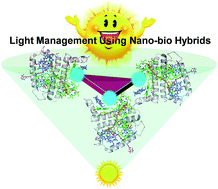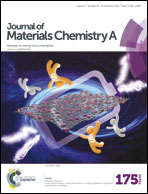Nano-bio hybrids of plasmonic metals/photosynthetic proteins for broad-band light absorption enhancement in organic solar cells†
Abstract
Photosynthetic proteins, such as light-harvesting complex II (LHCII), possess an excellent ability to harvest solar energy by means of highly efficient energy conversion. Here, we have prepared novel nano-bio hybrids by employing Ag nanoparticles as surface plasmons to couple with LHCII for optical enhancement in organic photovoltaics for the first time. And we have demonstrated that the incorporation of suitable Ag nanoprisms into nano-bio hybrids not only expands the absorption region through light trapping, but also enhances the photon-absorbing activity of molecular photosensitizers through localized surface plasmon resonance (LSPR) from the nanoprisms. The increased light absorption that results in enhanced photocurrent enables universal optical enhancement for multiple bulk heterojunction systems with maximum PCE up to 10.88%. We expect that our strategy for the construction of nano-bio hybrids through integration of metal nanostructures and photosynthetic biomolecules can provide a powerful and general means to enhance broad-band light harvesting in solar energy conversion applications.


 Please wait while we load your content...
Please wait while we load your content...